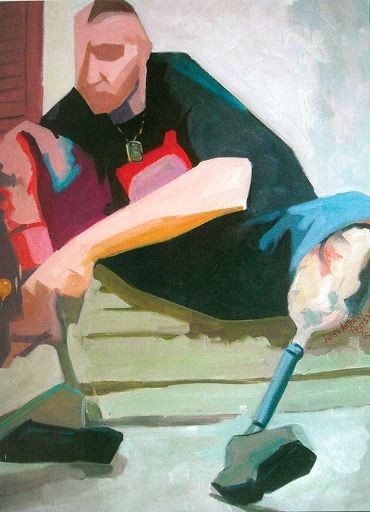The National Museum of Health and Medicine at Walter Reed Army Medical Center currently has two exhibits on display featuring work from the war on terrorism. Exhibits include Trauma Bay II, Balad, Iraq, which sets out actual artifacts from a temporary medical center once in place on Air Base Balad, and Wounded in Action: an Art Exhibition of Orthopaedic Advancements, which includes selections from a larger collection that displays different interpretations of what wounded in action means.
National Museum of Health and Medicine deputy director Tim Clarke Jr. explained how the Trauma Bay II exhibit came to be.
''The day that [the Balad] hospital was transferring from tent to permanent facility there was a congressional delegation that visited the base that day," he said. ''They heard of the heroism of the doctors and nurses that operated in this facility. They heard about the fact that this was the place where the most American lives were saved since Vietnam."
Clarke credits the moving of the tent to the museum as a result of the congressional delegation visit. Included in the exhibit is the very front portion of the tent including the doors. Once inside, visitors can admire a 7 x 7 foot piece of concrete floor from Trauma Bay II as well as view supplies that would have been in the tent.
''Trauma Bay II was where the worst wounded were treated," said Clarke. Although Trauma Bay II wasn't the only unit that cared for the servicemembers, ''This is the last place you'd be in Iraq if you were wounded in the field and needed to be airlifted out of the country," he added. Even if servicemembers were treated at a different medical facility in Iraq, any outgoing patients or servicemembers needing to leave the country would all pass through Balad.
''One thing we found out about this hospital is they treated anyone that arrived at the gate," Clarke said. ''If enemy personnel, injured civilians or contractors found their way to this hospital, personnel would stabilize them, save their life and then transfer them to the appropriate place. If they were a civilian they'd be sent back to the Iraqi hospital."
When [servicemembers recovering at Walter Reed] heard that this very unusual artifact was coming in from all the way over in Iraq, [and] into our care they became very emotional," said Clarke. ''They asked us if they could touch it, if they could see this thing before it was even unwrapped, before you even had a sense of what it looked like. It evokes a genuine emotional response."
This emotional experience is also present in the Wounded in Action art exhibit. Although not all the pieces are on show at the museum, there is a good mixture of different mediums used. From photography to empty shell casings and prosthetic legs, the artwork is made to evoke a feeling and present one person's interpretation of either being wounded in action or knowing someone who was wounded.
The exhibit opened in April and will close in February 2011. The artwork depicts a variety of stories and settings for the subjects.
''This is the story of a young man who was at a coffee shop in New Orleans. This artist saw this young man just reattaching his legs and going about his business and decided that he wanted to capture that spirit in this piece," said Clarke pointing to one piece of art.
The exhibit's book states that the painter Joseph A. Pearson was moved by the sacrifice the young man had made for America. Pearson's own mother had lost both her legs to diabetes and that inspired him to paint this veteran.
''What I've heard is mostly gratitude [from the military community]. These images are helping to tell their story. It may not be their story, exactly, but it is telling the grander story of the experience of people living with the wounds of war," Clarke said.
Those wishing to visit the museum should check the website www.nmhm.washingtondc.museum for updates. The museum will be moving next year to a new location in Forest Glen, Maryland, about four miles away from its current location as part of the Base Realignment and Closure Act of 2005.
''Our 150th anniversary is in May 2012. Our relocation is expected to occur by September 2011 and at the moment we are looking for a final date we will open to the public," Clarke said.


Social Sharing